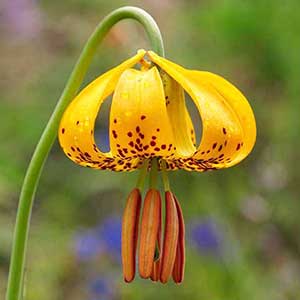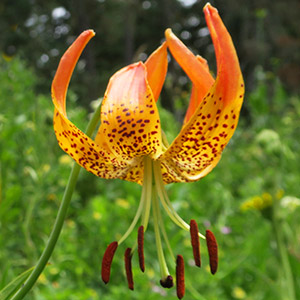Lilium columbianum
Lilium pardalinum
Columbia lily, Columbia tiger lily, Columbian lily, Oregon lily, tiger lily
California tiger lily, leopard lily, panther lily
variable, subrhizomatous to ± ovoid, 3.1–8.1 × 3.6–10.6 cm, 0.3–1.4 times taller than long;
scales 2–3(–5)-segmented, some unsegmented, longest 3.1–7.3 cm;
stem roots absent.
rhizomatous, usually branching, continuously scaly, 1.4–5.1 × 3.9–19 cm, 0.2–0.6 times taller than long;
scales sometimes unsegmented but always some 2–4-segmented on each bulb, longest 1–3.3 cm;
stem roots absent.
to 1.7 m, glaucous or not.
to 2.8 m, strongly clonal and thus forming dense colonies, to weakly clonal and forming small colonies or clumps.
rounded in cross section.
rounded in cross section.
in 1–9 whorls or partial whorls, 3–25 leaves per whorl, usually ascending, 1.7–15.7 × 0.4–4.7 cm, 2.4–7.4 times longer than wide;
blade weakly oblanceolate to obovate or ± elliptic, margins usually somewhat undulate, apex acute;
veins and margins ± smooth abaxially.
usually ± evenly distributed along stem, rarely concentrated proximally, scattered or in 1–6 whorls or partial whorls, 3–19 leaves per whorl, horizontal and drooping at tips to ascending, 4.9–26.5 × 0.3–5.6 cm, 3–34 times longer than wide;
blade usually ± elliptic, wide or narrow, margins usually not undulate, apex acute, often narrowly so;
veins and margins ± smooth abaxially.
racemose, 1–25(–45)-flowered.
racemose, 1–28(–35)-flowered.
pendent to nodding, not fragrant;
perianth Turk’s-cap-shaped;
sepals and petals reflexed 2/5–1/2 along length from base, yellow or orange to occasionally red, with copious maroon spots, often darker and especially reddish abaxially, not distinctly clawed;
sepals not ridged abaxially, appearing wide for their length, 3.4–7.1 × 0.8–1.9 cm;
petals 3.5–6.9 × 0.8–1.9 cm;
stamens barely to moderately exserted;
filaments moderately spreading, diverging 10°–20° from axis;
anthers pale yellow to yellow, 0.5–1.3 cm;
pollen orange or yellow;
pistil 2.4–3.7 cm;
ovary 1.1–2.2 cm;
style green;
pedicel 2.8–20.2 cm.
pendent, usually not fragrant;
perianth Turk’s-cap-shaped;
sepals and petals reflexed 1/4–1/3 along length from base, yellow, yellow-orange, or orange proximally, darker orange to red-orange to red on distal 1/5–3/5 (entirely orange or yellow-orange in subsp. wigginsii), with maroon spots concentrated proximally and always surrounded by yellow or orange if extending into distal reddish zone, conspicuously green abaxially on proximal ± 1/5, not distinctly clawed;
sepals not ridged abaxially, 3.5–10.4 × 0.9–2.2 cm;
petals 3.4–10.2 × 0.9–2.5 cm;
stamens moderately to strongly exserted;
filaments moderately to widely spreading, diverging 7°–22° from axis;
anthers ± magenta or sometimes orange, orange-pink, or pale yellow, 0.5–2.2 cm;
pollen red-brown, red-orange, brown-orange, rust, orange, or yellow;
pistil 3.1–7.5 cm;
ovary 1–2.2 cm;
style green, often pale, rarely sordid;
pedicel 6–32 cm.
2.2–5.4 × 1.1–2 cm, 1.7–3.3 times longer than wide.
2.2–5.7 × 1.2–2.1 cm, 1.5–3.7 times longer than wide.
135–330.
123–264.
= 24.
Lilium columbianum
Lilium pardalinum
The author citations often seen for this species derive from Baker (1874), who published the name as Lilium columbianum “Hanson in hort., Leichtlin”; this authority is given by various later writers as Hanson, or Baker, or Hanson ex Baker. However, Ducharte’s (1871) recapitulation of a letter from M. Leichtlin is apparently the first confirmed and valid publication of L. columbianum, and hence that citation is used here.
This widespread lily is rather variable. In California plants the stamens are considerably less exserted than those of plants found farther north. Lilium columbianum may intergrade with L. kelloggii along Highway 199 at the border between California and Oregon; these plants are slightly fragrant, the stamens moderately exserted, and the bulb scales unsegmented. Lilium columbianum hybridizes with L. pardalinum subspp. wigginsii and vollmeri, and extensively with L. occidentale in Oregon.
Lilium columbianum is pollinated primarily by rufous hummingbirds [Selasphorus rufus (J. F. Gmelin), family Trochilidae] and to a lesser extent by large butterflies, including the pale swallowtail (Papilio eurymedon Lucas, family Papilionidae).
Native Americans used Lilium columbianum bulbs as a food or peppery condiment, sometimes mixed with meat or salmon roe. For many, it was a staple food (J. Pojar and A. MacKinnon 1994).
(Discussion copyrighted by Flora of North America; reprinted with permission.)
Subspecies 5 (5 in the flora).
The subspecies of Lilium pardalinum display a classic pattern of discrete geographical ranges with intervening zones of introgression, and no two occur sympatrically without intermixing. Plants in the hybrid zones are confusing in appearance and cannot be assigned to subspecies. However, each subspecies is fairly well marked within its core distribution. With the exception of subsp. pitkinense, the subspecies of L. pardalinum can be common plants in the proper habitats within their rather narrow distributions.
Leaf size and shape are quite variable in Lilium pardalinum subspecies and often clearly dependent on environment. In populations that typically have narrow, ascending leaves, shaded plants often have wide, horizontal leaves. This hampers taxonomic separation as well as identification, especially of herbarium specimens. Further field study is desirable.
Lilium pardalinum is primarily pollinated by western tiger swallowtails (Papilio rutulus Lucas, family Papilionidae) and pale swallowtails (P. eurymedon Lucas); several species of hummingbirds (family Trochilidae) are also important visitors, especially when butterflies are rare.
The Atsugewi, Karok, and Yana ate Lilium pardalinum bulbs steamed or baked in an earth oven (D. E. Moerman 1986).
(Discussion copyrighted by Flora of North America; reprinted with permission.)
1. Sepals and petals uniformly yellow or yellow-orange; sepals 3.5–7.1 cm; anthers pale yellow, 0.5–1.3 cm; pollen yellow or orange; pistil 3.1–4.3 cm; capsules 2.3–4.2 cm; n California, s Oregon. | subsp. wigginsii |
1. Sepals and petals ± 2-toned, with yellow or orange proximally, distal 1/5–3/5 darker orange to red; sepals 3.7–10.4 cm; anthers magenta, occasionally purple or orange, 0.5–2.2 cm; pollen yellow to rust; pistil 3.3–7.5 cm; capsules 2.2–5.7 cm; California, s Oregon. | → 2 |
2. Sepals (5.9–)6.6–10.4 cm; anthers 1.1–2.2 cm; capsules 2.9–5.7 cm; leaves 3–12 times longer than wide, blade ± elliptic; stems strongly clonal, forming large colonies; California. | subsp. pardalinum |
2. Sepals 3.7–8.3 cm; anthers 0.5–1.8 cm; capsules 2.2–4.8 cm; leaves 3–34 times longer than wide, blade elliptic to linear; stems weakly to moderately clonal, sometimes forming small colonies; n California, s Oregon. | → 3 |
3. Leaves 7.3–34 times longer than wide, often concentrated proximally, often ascending, sometimes horizontal, blade ± linear; sepals (4.9–)5.3–8.3 cm; anthers 0.6–1.8 cm; pollen usually dark orange; extreme nw California, adjacent s Oregon. | subsp. vollmeri |
3. Leaves 3–17 times longer than wide, ± evenly distributed along stem, ± ascending or horizontal, blade ± elliptic; sepals 3.7–7.6 cm; anthers 0.5–1.4 cm; pollen yellow, orange, or red- or brown-orange; n California, s Oregon. | → 4 |
4. Pollen red- or brown-orange; anthers magenta; bulb scales usually 2-segmented; n Coast Ranges near Sebastopol, California. | subsp. pitkinense |
4. Pollen usually yellow or bright orange; anthers orange to magenta; bulb scales (1–)2–4-segmented; ne California, adjacent s Oregon. | subsp. shastense |
- Local floras:
BC,
CA,
OR,
WA
- Local Web sites:
CalFlora,
CalPhotos,
Flora NW,
PNW Herbaria,
Turner Photog.
WildflowerSearch
iNaturalist (observations)
USDA Plants Database
- LBJ Wildflower Center
- SEINet
- Plants of the World Online
- Encyclopedia of Life
- Wikipedia
- Google Image Search



